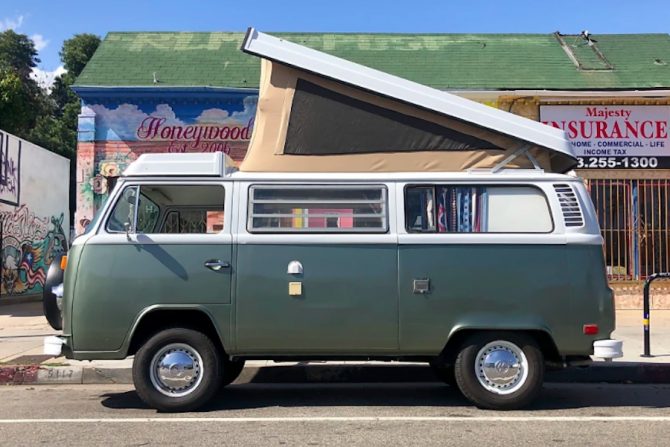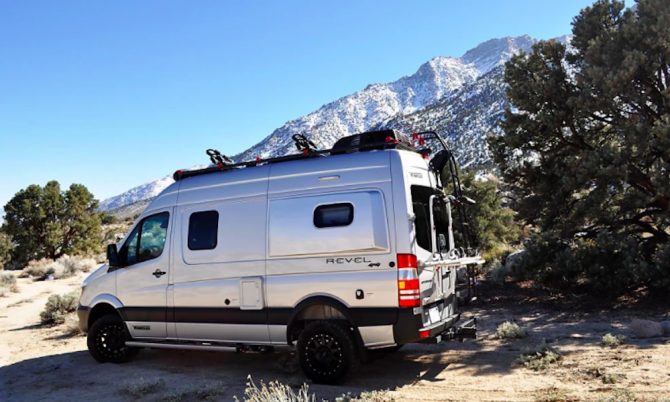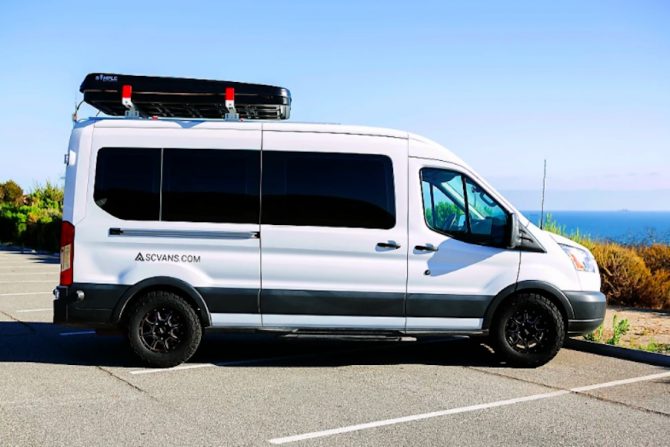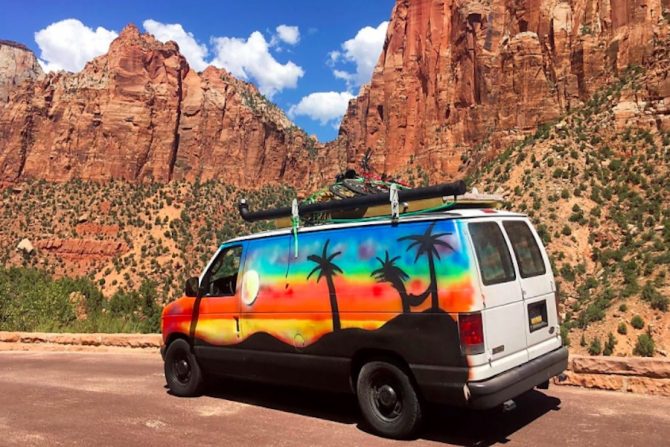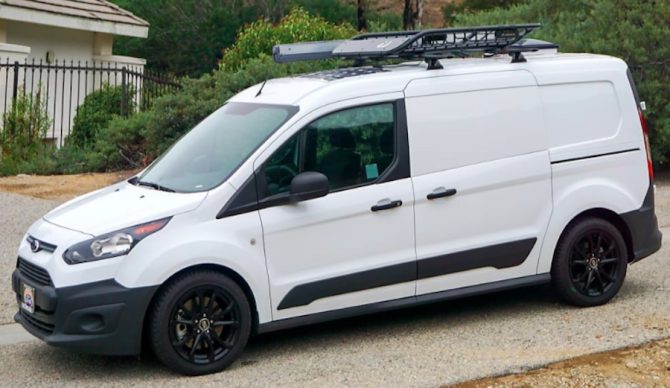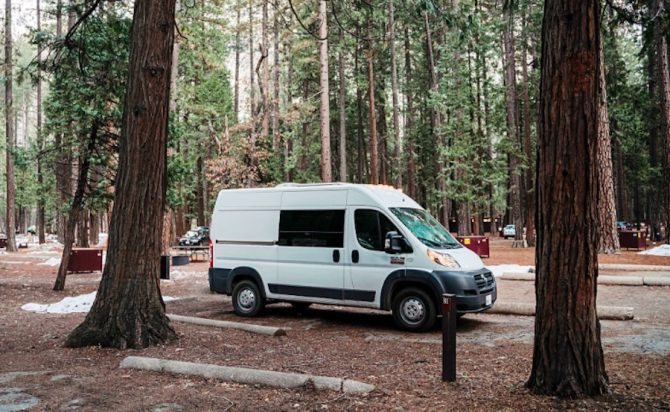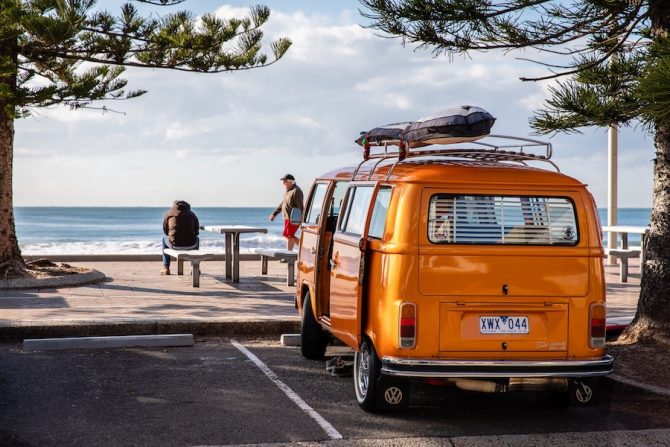
Living the life. Photo: Simon Rae
Camper van rentals may seem like a rather mundane chore that precedes the greatest trip of your life. But I’d recommend not relegating the process to the same list as renting insurance (which is equally important, and way less fun).
A camper van will be your home away from home for at least a few days, if not weeks on end, and when renting a home you want to make sure it fits more than your needs, but the heart of how you travel.
For a surf van, and a surf road trip, the type of van is even more critical. How many buds are taking this adventure with you? How many boards? Will there be dogs? Is there a separate cooler for beer? Spearfishing gear for lay days or glamping gear for Insta-perfect bonfires? If it’s all of the above, you’ll need a bigger van.
The camper van rental process is also a perfect chance to scope out a future purchase. I mean, who among us doesn’t want a fully dedicated surf vehicle?
Below, we highlight the top camper van rental models you should consider, where to get them, and general rental costs.
But first:
Camper Van Rental Companies
The main caveat of this article is that it’s about camper van rentals. As much fun as it is to buy a new van and spec it out yourself, most people don’t actually need a dedicated van for one or two surf trips a year.
Now, the beauty of the camper van rental is that you get all the luxury, the picturesque sunsets, the shelter from the storm, and sleeping with the dog, for a fraction of the upfront cost, and no stress about the repairs. If there’s one thing camper van owners will tell you – especially about those antique models – it’s that they break. And it’s hard to fix them.
So, where can you rent a camper van?
The first place to check is Outdoorsy. It’s the AirBnB of camper van rentals – individual owners rent their vans, set their prices, and provide whatever accommodations they want to provide.
If you’re the type that wants to look through unique camper van setups and pick the exact right model for you (at the right price point), then use Outdoorsy. The service is simple, the company has a great reputation, and there’s a huge marketplace of vans on there.
Not just camper vans — you can find full RVs, trailer campers, even rigged out 4x4s.
Costs range wildly depending on the type of vehicle, how upgraded it is, and who you’re dealing with, but we found acceptable camper vans for about $150 a night, not including gas.
If you want to go the other popular route, Escape Campervans is your best bet. This is the company that has a fleet of roughly four models, all of which are painted in recognizably-swirling colors.
Escape Campervans rents vans all over North America, and has many convenient locations on the West Coast.
In general they rent low-ceilinged Ford camper vans of increasing size, all of which have views out the back, beds, fridges, a stove, and storage. Costs range depending on model and time of year, but we found them for around $100 a night, not including gas.
Other Companies
While we could write an entire article about companies you could rent from, they all kind of boil down to the same thing with different rates, slightly different vehicles, and different policies.
If you aren’t stoked on Outdoorsy or Escape Campervans, look at GoRving, Travellers Autobarn, JUCY, or RVShare.
What does it cost to rent a camper van?
This is an important question, and unfortunately one that is very hard to answer. We’d like to give it an even $125 a night, so it sounds on par with most half-way decent hotels or your deluxe AirBnB, but of course it’s not so simple.
There are three main factors that change camper van rental price:
Time of Year
The busy time of year is more expensive, the slower is cheaper. Goes without saying, but I’ve said it, so there ya’ go.
Luckily for surfers, “busy” is typically the summer months. Don’t get me wrong – a surf trip in summer down to Baja does indeed sound excellent – but there will be better waves in Fall and Winter, which are both deemed “slow” times by the rental industry.
Outdoorsy prices may stay the same all year long, but a company like Escape Campervans has lower prices in winter every single year (but not around holidays).
One Way Trips vs. Round Trips
Much like car rental companies, some camper van rentals require you to do round-trip pick up and drop off (meaning at the same location), while others allow you to pick up in one location and drop off at another.
Say, for instance, that you want to road trip up the California, Oregon, and Washington coast, but need to be back in time for work, so you just fly home.
The cost is lower for a round trip than a one way trip. Though, depending on the service, it won’t be that much more expensive. We found it was about eight dollars more in the randomized search we did on Escape Campervans.
Take this into consideration when booking.
Base Price vs. Included Extras
The biggest issue with publishing prices is the “base price” versus what is “included.” Base price refers to the lowest price per day for just renting the vehicle. Extra costs can include gas, refrigerators, chargers, specific kinds of bedding for more people, unique kitchen gear for larger groups, or a bike rack, for instance.
You’ll want to review the fine print before all is said is done, especially on the cost of gas. Often companies sell a gas “package” up to a number of miles, which will be slightly discounted than if you just paid for the gas and mileage yourself.
Outdoorsy gets even trickier, as you’re dealing with individuals and their pricing structure.
Overall, it’s not exactly cheap to rent a camper van. You’ll want to budget anywhere from $700-$1000 for a week-long trip, which is a very general rough estimate.
The Camper Vans to Rent
Finally, the actual camper vans that I think you should rent. Most of these are the tried and true manufacturers and vehicles that have become iconic with surf trips over the last 60 years. Keep in mind that the dopeness of your road trip depends on the individual vehicle you get, how it fits with your overall group and goals, and if you hit the swell window.
Also, a disclaimer: While I have ridden in and assessed the overall vibe of each type of camper van on this list, I am not a car nut. The innumerable differences between make and model over many years does not excite me, nor do the thousands of small, meaningful upgrades that go into the ever-growing van customization industry.
In my opinion, that level of detail is best left for a van purchase, not a camper van rental.
- 2-4 people
- Low ceiling
- 15-foot length
- RWD, 4×4
This entire article probably wouldn’t exist without the Volkswagen Westfalia. Its iconic bus design is synonymous with hippies, surfers, and the recent van-life revival. Technically they were made between 1950 and 2003, with the most iconic being from the sixties and seventies, and the best performing from 1986-1991.
Given how much cars change over that span of years, listing every little feature is not at all practical, so here are the basics that most Volkswagen Westfalia come with:
- Foldout seat arrangements that allow you to sleep at night, dine and ride during the day
- Plywood interior panels for that seventies home-away-from-home look
- An ice box or cold-box, though recent renovations often put in a fridge instead
- A sink and stove (most, not all)
- Dedicated seating and sleeping for at least two, often four
- Sliding van door
- Pop-top bed
The Volkswagen Westfalia Campervan is perfect for small groups who want to share relatively close quarters while reminiscing about times in which they were probably not alive. They fit longboards easily, and have great windows for viewing the surf from any part of the vehicle.
Also, for reference, “Westfalia” is a larger categorical name for the Bus, the Vanagon, and Eurovan, three individual models that all have similar builds.
You can find a smattering of highly customized Westfalia on Outdoorsy.
CHECK PRICE ON Outdoorsy- 2-6 people
- High ceiling
- 19.5-foot length+
- RWD or 4×4
If a Westfalia is synonymous with old van-life culture, the Mercedes-Benz is the new high-end, outdoor-gear-head version that most surfers can only drool over. It’s a luxury vehicle that gets good gas mileage, comes in diesel and regular versions, and has made surfers believe they need copious headroom to embark on a surf trip.
Most Sprinters are built as light commercial vehicles – meant to ship goods – and don’t come with anything except two large, extra-high seats in the front, an excellent engine, and a standard eight-foot roof height.
Sprinters are the most popular camper van for full-blown customization. Most Sprinter camper vans that will work for surfing come with the following:
- At least three seats in the passenger row, increasing total buckled capacity to five. Some have an extra two or three seats beyond this.
- A built-in raised queen bed.
- Long, wide storage underneath the bed ideal for many boards and/or equipment.
I don’t want to get your hopes up, but Sprinters also often have sinks, stoves, fridges, small tables, elaborate storage, industrial roof racks, solar panels, and more. And higher-end models are 4x4s, which does make them better for accessing difficult surf spots.
We think this camper van is a high-end experience for two surfers, and a legitimate one for up to five. That said, the Sprinter typically only sleeps two in the van, so you’ll want to bring tents. And if you’re bringing more people, make sure the one you rent has seats. Storage, on the other hand, is sublime.
Also, while Mercedes-Benz is the most common manufacturer of the Sprinter, there are some models under the Dodge label.
CHECK PRICE ON Outdoorsy- 2-6 people
- High ceiling
- 18-foot length
- RWD, AWD
The Ford Transit is the other truly classic camper van on this list. In fact, it’s the third best-selling van of all time, and eats up a considerable market share in North America. But that’s because it’s used predominantly for its original purpose: transit of goods.
For some unknown reason the Sprinter is the more popular choice among camper van enthusiasts, despite their expense and high maintenance fees. Compared to the Sprinter, the Ford Transit is also a large, initially empty cargo van with two big seats up front and plenty of space to customize in the back.
When renting a camper van, I wouldn’t think too much about the difference between a Sprinter and a Transit. It’s large, fits boards aplenty, and really depends on the interior customization.
CHECK PRICE ON outdoorsy- 2-5 people
- Low ceiling
- 17-foot length
- RWD
The Ford Econoline – also known as the E-Series, including E-150, E-250, etc. – is the second-best selling van in the U.S. It was discontinued in 2015 to make way for the Transit as the top van dog, making it the modern age’s Westfalia. Just you watch – 50 years from now there will be fully decked-out Econolines with built-in holograms of Taylor Steele videos playing Pennywise CDs (they’ll be back).
The Econoline does have an iconic look, and it works quite well for a large group on a budget. They come in all sorts of configurations, and can hold anywhere from 2-8 people depending on the seat arrangement. They have a large sliding door, a long body, and a generally low ceiling that makes rooftop tent camping fun. This plus the double door opening on the rear makes it ideal for surf trips.
This is the main car that Escape Campervans rents, and they have a convertible queen bed that doubles as a daytime dining nook, a full kitchenette with 5-gallon sink, and plenty of curtains and storage space.
You can find Econolines fairly easily, and they are a solid surf vehicle for a group that’s comfortable sleeping outside the van.
CHECK PRICE ON outdoorsy- Two people
- Low ceiling
- 14.5-foot length
- FWD
The Ford Transit Connect is the camper van that’s most like a regular car. Built with a lot of the same parts as a Ford Focus, the Connect is basically a long, slightly high two-person camper van.
They can come stock with either two or four doors, and the interior customization will depend (as all of these do) on the individual car you rent.The trunk opens vertically and there’s just enough room for a bed and living setup.
Escape Campervans uses the Transit Connect as its Santa Cruz rental package, and it has a double bed, curtains for privacy, two sliding side doors, storage draws, and a small pullout sink and single burner stove.
If you rented one from Outdoorsy, the setup would be slightly different, but in general there’s a double bed and some storage.
This is a bare minimum camper van that will allow you and a friend (and the dog) to sleep indoors. It does get great gas mileage in comparison with larger vans, and can fit in any parking spot. Your boards will fit in the car while driving, or on a roof rack, but at night they’ll need to slide somewhere else.
CHECK PRICE ON outdoorsy- 2-6 people
- High ceiling (low ceiling option)
- 17.75-foot length
- FWD
The third option in the tall, extra-long variety of transit-based camper vans is the Ram ProMaster. The main claim to fame of the ProMaster is its square cargo area – the other vans are more rectangular in shape – which allows for simpler conversion builds (but it’s also a bit shorter than the Transit and Sprinter).
Otherwise, it’s a tall box with wheels that can be built to your needs. Nick Kelly of SoCal surfer bought an empty Ram ProMaster to build into a surf vehicle, mostly because “it’s the biggest van you can fit in a normal parking spot and it has front wheel drive.”
The front-wheel drive allows for better handling – more like a normal car – but doesn’t have as much traction because most of the weight in a camper van is over the back wheels. Depending on climate this could matter.
When renting, if you happen upon a surf-engineered ProMaster, the more the merrier. It will likely have a built-in bed, massive storage underneath, five seats, and require extra buddies to tent outside.
CHECK PRICE ON outdoorsy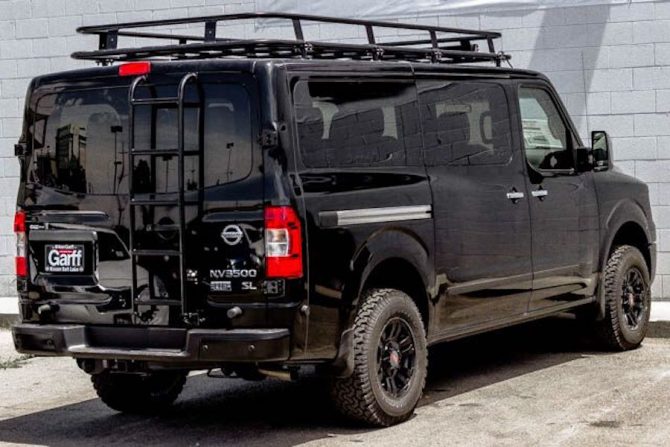
The Nissan NV 3500
Nissan NV 3500
- 2-12 people
- Low ceiling (high-ceiling version optional)
- 20-foot length
- RWD
The Nissan NV 3500 is a more unique offering in the camper van category. Technically, some may not even consider it a camper van, as its primary purpose is actually to haul passengers, not mustache-wielding millennials on a mission to find waves.
But friend and avid surfer Jeff Belzer of Ventura, CA, who owns Ventura Makos Surf Camp, chose the NV 3500 for a few specific reasons:
“I tried the Transit and Sprinter first, but because I needed a versatile box van that could operate in my daily life, while also taking many people on trips and to surf events, I went with the NV 3500. The kicker about the Nissan and how it won me over is that it was the only one that I could easily remove the seats for a camper like conversion, then switch back for passenger utility. Also, I could drive it in a parking garage.”
The van can holds 12 individual seats (and passengers) when fully loaded, or you can take out rows of seats individually and rearrange as needed. It comes in a low-top or high-top version (the high top is quite different), doesn’t have the price tag of the Sprinter, and may be harder to find on sites like Outdoorsy because it doesn’t have as much charm.
That said, if you’re looking to book a trip with the whole crew, consider the Nissan NV 3500, and bring a bunch of tents.
Honda Odyssey, Toyota Sienna, Your Mom’s Van
- 2-7 people
- Low ceiling
- 17-foot length
- FWD
It wouldn’t be a practical camper van rental list without a normal passenger van. Yes, the kind you went to soccer practice in. We all know the guy who’s still shuffling around in one of these with a custom black PVC shower pipe affixed to the top.
Why do people still use them? Because they work, they get great gas mileage, and they are easy to come by.
If you’re on the lookout for a truly cheap camper van, are going with a small group, or really don’t mind a cramped car and sleeping in tents, consider a passenger fan. The Honda Odyssey and Toyota Sienna are the two best models, mostly due to gas mileage, safety, and reliability, but any will work.
With roof racks and solid tie-down straps you can fit a bunch of boards on top, or if you’re traveling as two you can fit the boards in the car and sleep inside at night.
CHECK PRICE ON outdoorsy
